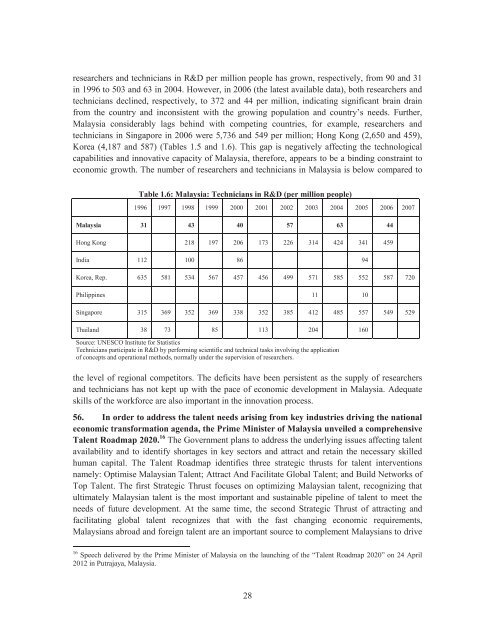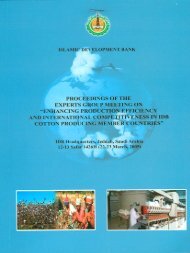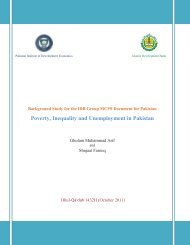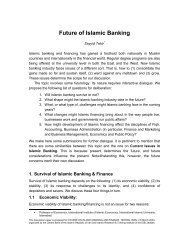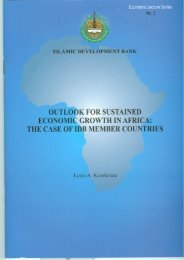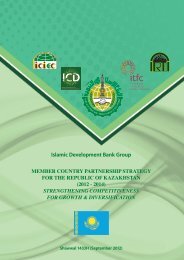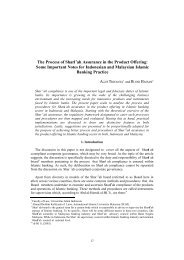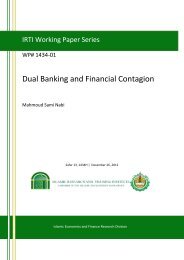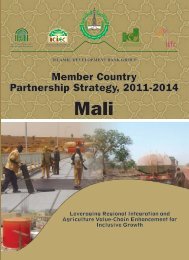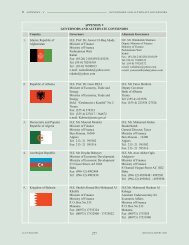Country Economic Work for Malaysia - Islamic Development Bank
Country Economic Work for Malaysia - Islamic Development Bank
Country Economic Work for Malaysia - Islamic Development Bank
You also want an ePaper? Increase the reach of your titles
YUMPU automatically turns print PDFs into web optimized ePapers that Google loves.
esearchers and technicians in R&D per million people has grown, respectively, from 90 and 31<br />
in 1996 to 503 and 63 in 2004. However, in 2006 (the latest available data), both researchers and<br />
technicians declined, respectively, to 372 and 44 per million, indicating significant brain drain<br />
from the country and inconsistent with the growing population and country’s needs. Further,<br />
<strong>Malaysia</strong> considerably lags behind with competing countries, <strong>for</strong> example, researchers and<br />
technicians in Singapore in 2006 were 5,736 and 549 per million; Hong Kong (2,650 and 459),<br />
Korea (4,187 and 587) (Tables 1.5 and 1.6). This gap is negatively affecting the technological<br />
capabilities and innovative capacity of <strong>Malaysia</strong>, there<strong>for</strong>e, appears to be a binding constraint to<br />
economic growth. The number of researchers and technicians in <strong>Malaysia</strong> is below compared to<br />
Table 1.6: <strong>Malaysia</strong>: Technicians in R&D (per million people)<br />
1996 1997 1998 1999 2000 2001 2002 2003 2004 2005 2006 2007<br />
<strong>Malaysia</strong> 31 43 40 57 63 44<br />
Hong Kong 218 197 206 173 226 314 424 341 459<br />
India 112 100 86 94<br />
Korea, Rep. 635 581 534 567 457 456 499 571 585 552 587 720<br />
Philippines 11 10<br />
Singapore 315 369 352 369 338 352 385 412 485 557 549 529<br />
Thailand 38 73 85 113 204 160<br />
Source: UNESCO Institute <strong>for</strong> Statistics<br />
Technicians participate in R&D by per<strong>for</strong>ming scientific and technical tasks involving the application<br />
of concepts and operational methods, normally under the supervision of researchers.<br />
the level of regional competitors. The deficits have been persistent as the supply of researchers<br />
and technicians has not kept up with the pace of economic development in <strong>Malaysia</strong>. Adequate<br />
skills of the work<strong>for</strong>ce are also important in the innovation process.<br />
56. In order to address the talent needs arising from key industries driving the national<br />
economic trans<strong>for</strong>mation agenda, the Prime Minister of <strong>Malaysia</strong> unveiled a comprehensive<br />
Talent Roadmap 2020. 16 The Government plans to address the underlying issues affecting talent<br />
availability and to identify shortages in key sectors and attract and retain the necessary skilled<br />
human capital. The Talent Roadmap identifies three strategic thrusts <strong>for</strong> talent interventions<br />
namely: Optimise <strong>Malaysia</strong>n Talent; Attract And Facilitate Global Talent; and Build Networks of<br />
Top Talent. The first Strategic Thrust focuses on optimizing <strong>Malaysia</strong>n talent, recognizing that<br />
ultimately <strong>Malaysia</strong>n talent is the most important and sustainable pipeline of talent to meet the<br />
needs of future development. At the same time, the second Strategic Thrust of attracting and<br />
facilitating global talent recognizes that with the fast changing economic requirements,<br />
<strong>Malaysia</strong>ns abroad and <strong>for</strong>eign talent are an important source to complement <strong>Malaysia</strong>ns to drive<br />
16 Speech delivered by the Prime Minister of <strong>Malaysia</strong> on the launching of the “Talent Roadmap 2020” on 24 April<br />
2012 in Putrajaya, <strong>Malaysia</strong>.<br />
28


